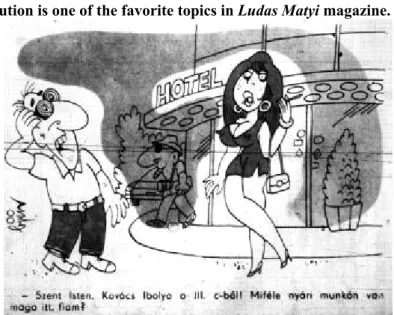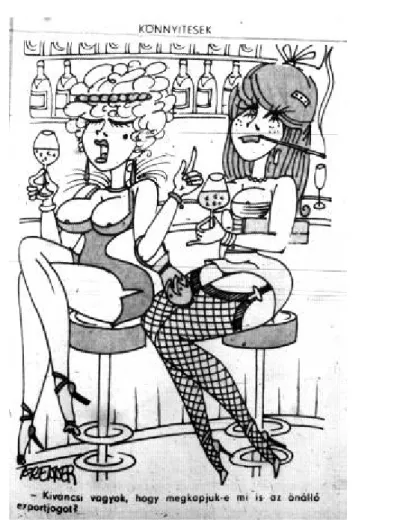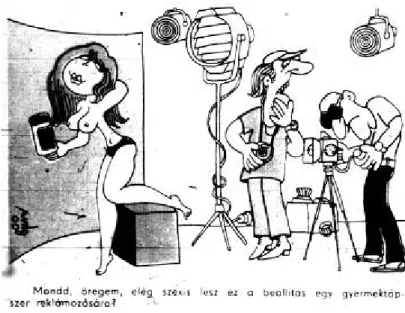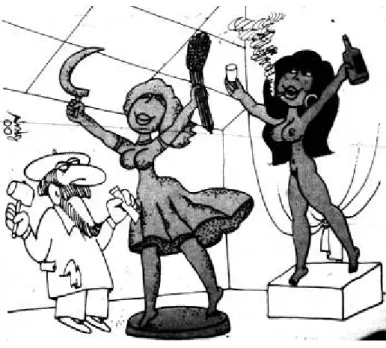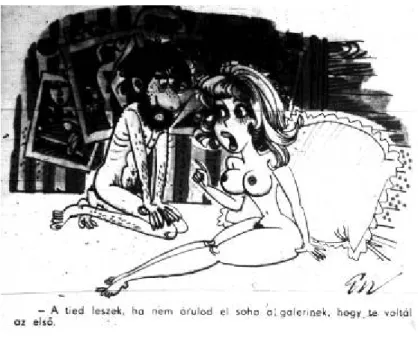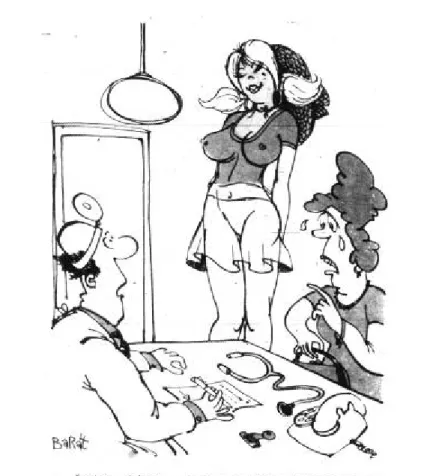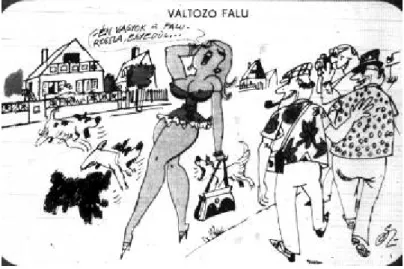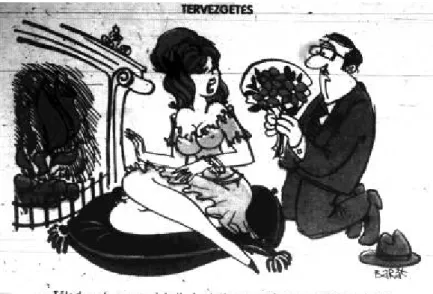UDK: 316.72-055.2(439)“198” Primljeno: siječanj 2010.
Representations of Sexuality in
Hungarian Popular Culture of the 1980s
Ana Magó-Maghiar
*SUMMARY
After pointing to the scarcity of research in sexuality and state-socialism the author traces the historical and social-political-economic setting in which the issues of Ludas Matyi the prolific Hungarian humor magazine were published. The body of the paper is taken up by the close reading of the sexualized joke illustrations of women published in the last decade of Hungarian state-social-ism. Through the thematic and semiotic analysis of about 30 illustrations the author describes a fully articulated sex-discourse running parallel with the more state sanctioned discourse of the socialist mother. Through her conclu-sions the author addresses some very important theoretical debates in cultural studies, the research of post-socialism and feminism.
First it inquires about the debate surrounding popular culture which has al-ways been framed in the context of a capitalist economic order. The thriving field of popular culture under state-socialism requires the reconsideration of the hitherto inherent connections between industrialized capitalist societies, consumerism and the mass production of popular culture.
Second, it shows that the dismissal of popular-culture sources as data for re-search leads to a one-sided picture of the state-socialist context, like the ubiq-uitously held belief that in socialism there was no sex. This conclusion has some implications for (feminist) methodological decision-making as well. Re-search that limits itself to the cultural products of high culture translates into a modernist/structuralist project with patriarchal overtones.
Third, and most importantly in this particular case of the Hungarian humor magazine Ludas Matyi and against the backdrop of the negotiation of the contents of the tolerate category of Hungarian cultural politics there seems to be a silent agreement between the socialist state and its male citizens at the
* Ana Magó-Maghiar is a PhD candidate at the Babeş-Bolyai University, Cluj,
expense of women. The state sought to buy the patience of the ’worker’ (its constituency) by allowing to pursue his own sexual interests on the condition that he is not going to question the legitimacy of the political regime.
Key words: Hungarian popular culture, humor magazine, socialist state, women, semiotic analysis, cultural studies
In the light of the scarce available literature to talk about sexuality and the state socialist regime in the same breath seems to be almost impossible. Admittedly, there have been a quite a few researches in the areas of gender and post/state-so-cialism but with a different focus than that of sexuality. Works like Superwomen and the Double Burden (Corrin. 1992) are overwhelmingly concerned with women and work, women in politics, women and education, women as mothers or women and health only sporadically touching on issues of representation (from a cultural studies view-point) or the processes of sexualization, which is the center of attention in this article. Another seminal text in this area is Barbara Einhorn’s Cinderella Goes to Market (1993) where one can find a whole chapter on the rep-resentation of women in literature and a fair consideration of the post-socialist boom in pornographic products, still heavily departs from the close reading of popular-cultural sources that I intend to do here.1 There are a few exceptions in feminist literature that take up the issue of female sexuality during this period, but most of the research concerns women’s reproductive rights and the issues sur-rounding it, like abortion debates, maternity leaves etc. (e.g. Kligman. 1998, von Ankum. 1993). Only a few books tackle sexuality under state-socialism (e.g. Es-sig. 1999, Berry. 1995) from the perspective of queer presence/homosexuality or the rise of the sex media after the fall, but their overall conclusion can be summa-rized in the quote by Igor Kon at the beginning of this chapter. These texts present the historical background and the social context for the cultural product that I am about to present in more detail. In what follows I endeavor to present an alterna-tive image of sexuality under state socialism the way it appeared in the last decade of socialism in Hungary. I argue that Igor Kon’s statement cannot be extended to the representation of sexuality in the Hungarian mainstream media let alone to popular culture. This argument is relevant for a number of issues. First, it is un-derlining the view that the socialist block cannot be treated as a monolith nor can the so-called ‘gulyás-socialism’ of the Kádár regime. The latter brought a signifi-cant relaxation to the rules in general, especially in the field of cultural politics. Second, the argument is questioning the ubiquitous East/West divide used in the works of certain feminist scholars, social scientists or political analysts (Frunză
hy-pothesis is that from the perspective of popular culture the image of sexuality during the socialist regime is more nuanced and in the Hungarian context it allows for the parallel articulation2 of a more or less coherent double stance on sexuality, which Mária Adamik has called the ‘maternity-leave discourse’ and the ‘sex-dis-course’ (Adamik, 2000). I argue that in popular culture the latter is clearly articu-lated thus establishing that turning to popular cultural sources enriches one’s view of a specific cultural context. Surely, other specificities of this country in the 1980’s also influenced this state of affairs. For example because Hungarians could travel abroad relatively easily and because Hungarian tourism flourished, the country has participated in and reacted to the transnational cultural trends of the time, like the sexual revolution, the Hippy movement, the student riots in France of 1968 or heavy metal and punk-rock trends. Since 1968 in building the so-called ‘socialism with a human face’ Hungary has slowly been changing and appropriat-ing petit-bourgeois capitalist features both in its economic and cultural fields. One could state then that the transition period in Hungary from a state-controlled econ-omy to a market-oriented one has been started a few decades before 1989. And, as I will show, the cultural field was one of the most prominent ones in the process. In terms of cultural politics this meant a relaxation of the rules and a relative autonomy of cultural production, which in turn allowed for a more explicit take on issues of sexuality.
Cultural politics in the 1980’s
Melinda Kalmár, in her Ennivaló és Hozomány – 1998 [Food and Dowry] argues that “the political regime after 1956 deemed it of utmost importance to transform the bankrupt communist regime, to restore it to function and to maintain its effi-ciency in the long run without major changes, i.e. to sanitize it.” (Kalmár, 1998:12) When it comes to cultural politics, the period between the fall of the 1956 uprising and 1988 is often referred to by Hungarian historiographers as the “Aczél regime.” György Aczél was a founding member of the Central Committee of the Hungarian Socialist Labour Party (HSLP) in December 1956 and although his official position changed a lot during the years he is seen as the agent of the main principles of cultural politics in Hungary. (Kalmár 1998, Drabancz & Fónai 2005, Kisantal & Menyhért 2005) The fundamental rule of his policy was desig-nated by the name of ‘the principle of the three T-s’ made up of the first letters of the Hungarian words támogat, tűr, tilt. The first one, támogat means support and it marks the category applied to art projects that were seen to speak to large crowds and were judged ideologically correct because in line with the official cultural po-litical line of the party. Tűr means tolerate and refers to those cultural enterprises
that were not considered to be ‘correct’ in the sense above yet were not seen as threatening for the political and ideological ideals of the day. Lastly, tilt means forbid and it is supposed to be applied in case of those cultural endeavors that were deemed politically dangerous, violating the alleged common moral values. Aczél developed this system of evaluation in the 1950s and it was publicly an-nounced in 1958. Most scholars argue that the same framework was adopted and reinforced in 1977 and 1982 when the Central Committee of the HSLP reformu-lated its cultural politics. (Kalmár, 1998) In reality this policy in general was alter-nating between enforcement and toleration (Kisantal & Menyhért, 2005:119) and “in practice the debates around art and cultural politics were centered upon a broader or narrower definition of the tolerate [tűr] category.” (Bolvári-Takács, 1998: 25) In fact, an official document put together by György Aczél in 1984 at-tests to the liberalization of cultural politics by ignoring the tolerate category alto-gether and “subscribing to the importance of maintaining creative freedom re-gardless of style, topic or method.” (Bolvári-Takács, 1998: 35) This is why most scholars agree that “from the middle of the 80’s on culture and arts became totally independent” (Drabancz & Fónai, 2005: 222) of immediate party-political inter-ests. Furthermore, “in 1987-88 the processes in the cultural field tightly correlated with the changes in the political. The political changes in 1989 were partly in-duced by the artists, who were an active factor in the dismemberment of the late Kádár-regime and in the preparation for transition.” (Drabancz & Fónai, 2005:224) It is in this context of ongoing negotiation that one has to place any cultural product from that period.
Ludas Matyi, political erotica
3“On the other hand it is more and more clear that Hungarian cultural life was perhaps more efficiently tied to the novelties of the English and French tradition by the iron curtain and censorship than by the long-awaited free-dom […]”
Klaniczay (2003: 141)
Historical background
Ludas Matyi has a long history in Hungarian humor. Established in 1945 it gave voice to severe political criticism with a few exceptional periods, like the one di-rectly preceding 1956. The journalist Ferenc László in an article about the history of Ludas Matyi (Magyar Narancs, 2007 Jan. 25) states that after 1957 the editors and authors “were free to address the reality of more everyday issues,” of course
within certain limits. They could poke fun at the clerks and the members of the different companies’ middle management but they could not touch the executives and the higher ranked party politicians. The weekly editions reaching 600,000 copies by the 1960s effectively addressed the current political, economic and cul-tural issues. During the economic and political changes started after 1968 Ludas Matyi became the forum where the contradictions or limitations of the new poli-cies could be debated. Most importantly the scandals which more or less regularly surrounded the publication were connected to issues like the 1956 revolution (1957), the ‘excessive’ criticism of party officials (1961), international politics (1970) or the most severely punished criticism of inflation (early 1980s). In the last decade of state socialism Ludas Matyi was flourishing and “taking advantage of the more relaxed atmosphere and the liveliness of the media market.” (Magyar Narancs, 2007 Jan. 25) This is the period when it gave birth to other publications like the Ludas Magazine (1970s) or the more erotic Tollasbál (1960s). Unfortu-nately, after 1990 every attempt made by the editorial board to achieve economic independence failed so that the last issue of Ludas Matyi was published in 1992.
Methodology
Laura Kipnis in her analysis of the way sexual humor works in Hustler magazine has some relevant insights for my own research. Addressing the satisfaction that the audience of the publication might get from reading it, Kipnis states: “[t]hat sense of pleasure and danger that violation of pollution taboos invokes in us clearly depends on the existence, within every culture, of symbolic maps and codes. These are, for the most part, only semiconscious” (Kipnis, 1999: 143). The popularity of the Hungarian publication can only be explained if we admit that its humor works the same way. That is, it draws on – among other things – these shared cultural practices of sexual politics. By examining Ludas Matyi my aim is to explore the relevant cultural map of the period regarding (female) sexuality. In relation to this magazine I am interested in how an item of popular culture situ-ated right on the border between the two categories of cultural politics (described in the previous section) tolerate and forbid4 takes up the issue of sexuality. I do not want to analyze this data as representative of the category of ‘prohibition’, but it is a forum that comes closest to that category. I believe that there are some ge-neric characteristics, mostly related to the genre of humor which allow for a more resistant stance and could push some of the actual issues of the magazine into the forbid category. Besides, through the analysis of this data I can show the struggle over where to draw the boundary between toleration and prohibition.
The reason for me to choose popular culture is twofold. The fact that popular cul-tural products were just as much the object of the culcul-tural political regulations of the time show that one cannot stop at the analysis of high culture. Additionally I argue that by looking at these specific works, an alternative image of sexuality is emerging that allows for a more nuanced view on sexuality in state socialism. For my present analysis I went through all the issues of Ludas Matyi from 1980 to 1988 (approx. 416), the decade preceding the demise of the state-socialist regime, a period befitting analysis of rapid political change. For a discourse analysis of visual representations I concentrated on illustrated jokes. Of all the issues I chose 33 visual examples that had obvious sexual connotations and I found most inter-esting for my topic. I tried to have relatively the same amount of pictures to cover the whole decade, but inevitably some years are better represented than others. Namely I worked with two illustrations from 1980, eight from the year 1981, one from 1982, ten pictures date back to 1985, two are from 1986, five were drawn in 1987 and three in 1988. In this paper I only included nine of the most representa-tive ones. Although always present, jokes with sexual connotations were not the dominant type. Most issues contain a double page half-way through the edition ironically marked as “Over/Under 18” or in some cases “Over 16” but as I re-searched I concluded that there is no common trait of the images gathered under this caption and that using it was just a way of pointing out its futility. Therefore I chose the illustrations regardless of where they were placed in the magazine. The aim of this article is to describe the discourse surrounding women’s sexuality in the last decade of state-socialist Hungary with special attention to the ‘other’ of the sanitized image of sexuality, the sex-discourse. As I have already depicted the historical background, the social context and the modes of production, I will pro-ceed with a textual analysis of the data. First I will present a thematic analysis, i.e. I will analyze the pictures by four thematic clusters in order to offer an overview of the modalities in which sexualized representations of women occurred on the pages of the magazine. Then I will follow with a semiotic analysis of the prevail-ing models of femininity featured in the caricatures with the aim that a comparison of the two characters will emphasize their hopeless incompatibility. The close reading of the data will be followed by the articulation of the sex-discourse as I perceive it through the lens of these images.
Whores and desolate housewives
Ludas Matyi was a Hungarian popular weekly magazine of political satire. The dialectic of “saying without saying”5 (Magyar Narancs, 2007, Jan.25) which ac-cording to Ferenc László was the paradigm of the publication, closely emulates the argument advanced by Laura Kipnis that “the pleasures and displeasures of jokes
– jokes are often a coded way of saying something slightly transgressive – are probably not unrelated to the transgressive pleasures and displeasures of pornog-raphy” (Kipnis, 1999: 144). Actually, in the case of Ludas Matyi I would rate the transgression as quite radical, but still within certain limits, i.e. still seen as ‘pub-lishable’ for the general public. The joke form offers the authors as well as the readers the alibi of ‘men are having fun’ while at the same time delivering the im-plied pleasures of all sorts of social criticism. But as I will show in this chapter this kind of transgression is quite ‘ambivalent’, because not all forms of critique of the status-quo, even if launched by the dispossessed, is inherently transgressive rather it is often complicit with conservative values and political ideals.
There are two major ways for the portrayal of women which parallel the two ex-isting discourses on female sexuality, namely the sanitized image of sexuality and the sex-discourse. The protagonist of the latter, the sexualized woman gains much more visibility and we are to conclude that it is of more interest than the other one. The following analysis is meant to provide the range of contexts and its specifici-ties in which the caricatures from Ludas Matyi picture young sexualized women. I created four separate categories, that is prostitution, explicit social critique, sexual liberation and tourism in Hungary. These distinctions are based on my interpreta-tion of the emphasis that the images exhibited, but surely alternative principles of framing are also possible.
1. Prostitution is one of the favorite topics in Ludas Matyi magazine.
Figure 1. – My God, it’s Kovács Ibolya from grade III C! What kind of summer job are you here for? – Sept. 4, 1985
Figure 2. Facilities. – I am wondering if we are also going to get the right to export. – Feb. 5, 1986
In these illustrations the representation of prostitution is not the ultimate goal, rather the phenomenon becomes naturalized, by treating it as the means through which the authors point their critique to something else, such as the embarrass-ment of teacher and high school student in this situation or the caricatures of new deregulations of export-import rights. The image of Hungarian prostitution in these pictures is radically different from the ‘sanitized’ references encountered in the state commissioned books about proper sexuality (Körmendy, 1981: 77) or pop psychology sexual education manuals (Bágyoni, 1985, Szilágyi, 1983 and 1988), where it is presented as a social problem of deviance. These ‘girls’ don’t
seem to be concerned about the illicit nature of their activities nor the undignified and dangerous position that they are in, but rather look young and healthy infer-ring a sense of agency about themselves. The jokes work especially because of the ‘serious’ calculation that these women are engaged in does not fit their image of shallow sexual playmates. Fig. 1 is an interesting example of how the excuse of focusing on the precocious teenager can be an opportunity for ridiculing the ‘de-praved’ intelligentsia (the teacher) for ‘visiting’ prostitutes. The ‘working girls’ are portrayed in public places like the street, the bar or the hotel not concerned about social sanctions, although their revealing attire leaves no doubt about their business.
2. Similarly, explicit social criticism is articulated by referring to (mostly) female sexuality.
Fig. 3. – Tell me mate, is this set up sexy enough for a baby food ad? – Jan 29, 1981
It is interesting to see how women’s naked bodies are the universal means for all kinds of social criticism. In one of the caricatures a fully dressed young lady is re-clining in a chaise-longue holding a telephone while a middle-aged couple is looking at her. The caption says: “I’m still waiting for a phone in Budapest and my daughter is a call-girl in Paris.” is an excellent example of the multiple layers
that these jokes work on. The depicted situation is an opportunity for the author to point at Hungarian economic hardships – long waiting list for telephones – as an effect of state controlled ‘planned’ economy and to address at the same time the controversial issue of a particular example of dissidence. Packaging it as humor Ludas Matyi manages to mock different aspects of Hungarian socialism, for e.g. the status of artists by pointing at the contradiction between ‘reality’ and the ideologically correct image (Fig. 4.) or its reverse, the overwhelming sexualization of society (Fig. 3). The possibility for Ludas Matyi to set itself up as simultane-ously critical of socialist slogans as well as more capitalist/liberal trends (consum-erism, eroticization) confers additional value to the magazine and opens up the possibility to examine the relevance of Kipnis’ argument in relation with Hustler. “Not content to offend only the Right, it makes doubly sure to offend liberals; not content merely to taunt whites, it hectors blacks and other minorities.” (Kipnis, 1999: 157) Surely, Ludas Matyi did not allow itself to outright offend, but it pre-sented its readers with the opportunity to deride both the hypocritical values of the conservative socialist regime and the inherent contradictions of the discourse around sexual liberation (of Western origin). Poking fun at the dominant as well as the subordinate groups is what makes Ludas Matyi transgressive.
3. There are instances in which the periodical more explicitly addresses issues of sexuality.
Figure 5. – I’ll be yours if you never tell the gang that you were the first one. – Jan. 29, 1981
When Ludas Matyi addresses issues of sexuality directly it usually takes up topics like teenage sexual activity (Fig. 5. and Fig. 1.) or the contradictions of the sex-discourse (Fig. 6). Through its criticism the magazine deviates from the sex-discourses disseminated by the ideas of sexual liberation and unveils their nature as dictated by fashion as well as their contradictions. This is the flip side of the discourse of ‘openly talking about sex’. But criticizing one side doesn’t mean a return to the other, i.e. to the officially sanctioned, sanitized images of sexuality. Instead young, beautiful and exaggeratedly naked women in Ludas Matyi are ironically portrayed as the agents of their lives. In fact this is a male fantasy, drawn by male cartoonists for a male-owned publication – if it is possible to attribute a gender to a paternalist state. I will extend this idea, later when discussing the model of femininity.
Fig. 6. – Please doctor, help me. This year she only wants to go to a boys’ camp. – July 24, 1985
4. A distinct part of the periodical’s jokes deals with different aspects of Hungarian tourism. Most importantly it is of interest how women’s sexuality plays a central role in this field as well.
When it comes to tourism, one of the most mocked aspects is related to sexual services. Fig. 8 is a daring remark on the sex tourism industry that flourished in Hungary at the time, mostly catering to the foreign clientele at Lake Balaton. Similarly rural tourism appears to take advantage of local beauties which in turn alter the image of the Hungarian village (Fig. 7), a transformation more mocked than mourned by the authors at Ludas. The pictures above refer to distinct types of
tourism in Hungary. Fig. 8 is inarguably the representation of Lake Balaton refer-enced by the image of the hotel and the sailing boats. This is a site specifically ori-ented towards the foreigner. But in the 1980s as the resorts on Lake Balaton have started to reach their full potential the government’s intention was to attract for-eigners to other parts of the country. Fig. 7. is an example in this sense and an im-plicit criticism to the costs of foreign tourism in the countryside (referenced by the patterned shirts of the men). In another caricature a young lady dressed in tradi-tional costume but with a generous neckline is standing at the corner of a village house ‘holding’ a key between her breasts. A middle-aged couple of arguably Hungarian tourists approach and the caption provides the words of the woman: “Don’t move Dezső (male first name) I’m going to get the key myself”. This pic-ture is meant to illustrate internal rural tourism. Tellingly, this is the only one that features the middle-aged woman taking charge of her partner’s sexual activity. There is a shift in the portrayal of the sexualized beauty as well. While for target-ing foreigners they are seen to adopt an exaggeratedly revealtarget-ing Western-type of clothing, the Hungarian tourist is assumed to appreciate the national version of female beauty.
Figure 7. Changing Village (she is singing a popular folk song called “I am the worst bad boy of my village” and the three dots indicate “all dogs are barking at me” which is the next line. – June 29, 1985
Figure 8. – Marketing strategy (the poster says: At your disposal) – July 29, 1987 In conclusion let me summarize the characteristics of the ‘leading star’ of the sex-discourse with the following image:
Fig. 9. Planning – From you I only want your name, from Jocó a child, and from my parents the house. – Feb. 19, 1981
This model is definitely the winner on the pages of Ludas Matyi, because she has the power (most often the sexual power) to get what she wants. The ultimate cold-headed beauty is presented to us in Fig. 9. where she is determined to take advan-tage of all her prerogatives. The pun is on the woman herself, showing her as unaf-fectionate, materialistic, excessively rational and selfish desiring to take control of finances/household and family, thus unattractive. She represents by herself the general category of the beautiful, emancipated, and sexually liberated but calcu-lated young woman, the protagonist of the sex-discourse. Admittedly, Ludas Matyi constructs the caricature of this woman emphasizing the extremes that the sex-dis-course can lead to. Although it formulates a critique of the ‘modern woman’ it does not go as far as questioning the pleasures involved in her spectacle, rather draws on them to trigger amusement. The pictured women are teenage high school students, young secretaries, models or prostitutes who always know what they want and have clear plans on how to get it. In these portrayals there is the general tendency to use, to naturalize women’s sexuality as ‘manipulative/oriented to-wards money only’ as successful expectations to work in the jokes.
The category of the young and beautiful is also very interested in sex. But this kind of sexuality doesn’t have a moral edge, not for the prostitutes, the models, or the teenagers. Sexuality is just a means through which these women get to more important things like status and money. There is an implicit assumption here that women’s sexuality is naturally amoral, because they cannot help but use it for material ends which is in fact a more developed notion of women’s dependence on men. It is also important to note that their bodies are the ones that most often get represented naked. Being the object of the male gaze they provide the entire spec-tacle. The older women are always clothed as well as most of the men.
If we look at the iconography of the female body it is interesting to note that the overemphasis of large breasts and buttocks combined with long legs and full lips, not only goes against the small-breasted beauty ideal of the eighties, but completes the sexualization of women in quite similar ways as contemporary pornography. There is a second category of women that gets represented in Ludas Matyi and in this context it stands for the woman imagined by the sanitized discourse on sexu-ality. In the magazine she is portrayed as the ultimate loser, old, fat and ugly but above all almost absurdly asexual. In one picture from July 1985 there are two older women talking through an open window. The one inside the house is obvi-ously cooking at the stove. The other says: “Finally we can talk in peace. My hus-band has picked up and brought home some chick.” They represent the older ver-sions of the woman tourist who tried to control her husband’s sexual life. Their iconography is just as telling. They are dressed in black, their bodies are nothing but a blob and more importantly their facial features are not even represented.
They don’t have eyes or mouths, just a big nose hanging out of their indistinct hairdos. This feature of their representation stands in strong contrast with the rep-resentation of the sexually attractive, scantily clad female, where there is a strong emphasis on eyes, hair and mouth, as well as according to the pornographic aes-thetic on breasts, buttocks and legs.
Clearly, the message is that women’s destiny is to make the most of their lives while they are young and beautiful because once they marry they grow fat and ugly, will be cheated on by their husbands and lose all interest in sex while men undisturbed by their age and ugliness go on with their sex lives supported all the lives by their unattractive wives who are never too old to clean and cook. The pa-triarchal bias is evidenced by the way men manage to take advantage of the privi-lege to be ‘ordinary’.
Conclusion – political erotica
In her examination of Hustler, Laura Kipnis writes: “The power of grossness is very simply its opposition to high culture and official culture, which feeds the continual need to protect itself against the debasements of the low (the lower classes, low culture, the lower body…” (Kipnis, 1999:137) In a different cultural and social context resistance to official discourses – be it socialist or capitalist in-spired – is enacted on the pages of humor magazines, which under the excuse of laughter offer its skilled readers the possibility of dissent.
The above analysis gives sufficient evidence to support the argument that seeing state-socialism as asexual, or even too sanitized is a one-sided picture. In the case of Ludas Matyi female sexuality was used as packaging for the formulation of radical critique of the status-quo, which was a more sensitive issue in the eyes of the political regime than anything else.
It is imperative to observe that the middle category of Hungarian cultural politics was in flux due to the constant negotiation of it between a paternalist state and its male workers. A sort of agreement was reached at the expense of women, thus recreating the conditions of the sexual contract described by Carol Pateman as the universal right of men to women’s bodies (Pateman, 1988). The ‘brotherhood of men’ was necessary because this is how an oppressive regime sought to buy the patience of its male (and implicitly more dangerous) citizens, while keeping up the image of ‘constructing socialism with a human face’. On the other side men have benefited from the construction of male sexuality as free of responsibility and moral concern while keeping up gender inequalities in the family.
Although criticizing both discourses on sexuality the Ludas Matyi stance on women’s sexuality is limited in many ways. On the one hand it mocks young,
beautiful women for using their sexual powers for material gains, while it forgets about the (s)exploitation inherent in profit-making or the social stigma that sur-rounds these activities. On the other hand it derides older women as asexual losers stressing the incompatibility of the two sides of the whore/madonna or sex-dis-course/sanitized image of sexuality dichotomy. Female ‘success’ is naturally amoral, but older and ugly women are stupid not to understand that no ‘decent’ man could want them.
When sexuality is not portrayed for its own sake as it is in this case, there is the possibility of greater complexity. Laura Kipnis claims that the simple fact “[t]hat more of the naked bodies are female and that many are in what might be described as a service relation to male bodies opens up the possibility of misogyny charges. But what becomes problematic for such a singular reading is that within the par-ody, the imaginary staging of the rituals of male sexual power functions in favor of an overtly political critique.” (Kipnis, 1999:153) On the other hand, is this kind of transgression to the advantage of women? I believe that the mere defiance of the rules is not necessarily a feminist project, because here, in the case of Ludas Matyi harsh social criticism still keeps the sexual contract in its place and it doesn’t question women’s position in society to a satisfying degree.
Instead I advocate the individual assessment of each cultural product that entails representations of female sexuality, in order to establish its progressive or conser-vative nature in a specific historical and social context.
In 1997 Éva Fodor in her Ph.D. dissertation argues that “certain forms of the commodification of the female body, in particular in advertisements, prostitution, or pornography, were strictly forbidden and largely absent from overt practices. Women’s magazines emphasized cleanliness and efficiency rather than fashion, make-up adornment – women’s bodies were under less publicly approved scrutiny than in Western societies.” (Fodor, cited in Adamik, 2000: 186) This argument, complemented by Adamik’s observation that the issue of female sexuality has not been addressed under state-socialism (Adamik, 2000:170) and supported by Vera Sokolová’s statement that “sex under communism was either represented through officially sanctioned channels or not represented at all” are possible because of a methodological bias. Popular culture is most often ignored, but even when consid-ered (Fodor) it is not seen in its contradictory complexity. Through the case study of sexuality in the Hungarian magazine Ludas Matyi I meant to point at the com-plexities of popular cultural sources. In the case of Hungary it is possible to find representative works for all categories of cultural politics (support, tolerate and forbid) – some of it endorsing the official discourse on sexuality, other parts situ-ating themselves in the negotiated category while some other cultural products crossed the line from time to time and got penalized for it.
Therefore my analysis has important implications for the study of popular culture. First, it is impossible to posit popular culture as inherently normalizing or subver-sive because the field is too complex. It may be normalizing in a certain aspect (in gender relations in the above example) but transgressive in others (critique of the status-quo above). Second, popular culture is not contingent on a political regime. Moreover in its details it shows great similarities across political and economic re-gimes. Therefore there is the need to abandon the inherent connections between capitalism, consumerism and popular culture. Finally, gendering popular culture is similarly difficult, as it addresses both women and men (as in the case of Ludas Matyi). Its gendering as feminine can only be justified by the masculine bias of patriarchy, afraid of contamination by its other.
From the perspective of my analysis, the most important aspect of the debate on popular culture is the fact that it is exclusively framed in the context of a capitalist economic order. Then a legitimate question to inquire is about the status of popu-lar culture under state-socialism. The lack of research in this regard is especially intriguing when one takes into account the resistant potential in positioning popu-lar culture as against ‘the power-bloc’ by Stuart Hall and John Fiske alike. I argue that the marginalization of popular culture in scholarship concerning the ways of the state-socialist regime translates into a modernist project with patriarchal over-tones. Moreover, in agreement with Dina Iordanova, who states that the Western picture on Eastern European cultural production (in her case cinema) is severely one-sided, because Western audiences were only interested in/only had access to cerebral or highly politicized and censored works (Iordanova, 2003: 27) I also ar-gue that ignoring the items of popular culture from the state-socialist period fore-closes the understanding of the complexity of cultural production under state-so-cialist regimes.
Applying the theory of popular culture to this different economic and political context has important implications. The thriving field of popular culture under state-socialism offers the base for reconsidering the hitherto inherent connections between industrialized capitalist societies, consumerism and the mass production of popular culture. Similarly, framing popular cultural production as ‘oppositional’ to the state is untenable because in Hungary it was explicit party policies that tried to regulate the emergence of an ‘ideologically correct’ popular culture as well the boundaries within the categories through the policy of the three T’s. See for fur-ther reading the article of Bence Tordai who claims that in Hungary the incapacity to formulate a coherent ‘ideologically correct’ popular culture for the socialist in-dividual was one of the significant vulnerabilities of the system and eventually led to its demise.6
Therefore I argue that turning to the study of popular culture in state-socialist re-gimes is a necessary step in order to understand the complexities of everyday life during these political regimes. Taking popular culture seriously also means re-nouncing elitist methodologies and accepting the postmodern condition of blurring the boundaries between high-culture and its ‘other’, i.e. popular culture. At the same time it is a significant feminist project because it sets out to deconstruct the gendering of popular culture as feminine, undermining women’s status as ‘proper’ cultural citizens. Moreover, researching state socialist popular culture will eventu-ally provide us with a better understanding of different cultural practices charac-teristic of the post-state socialist context.
ENDNOTES
1 More recent publications include Kay (2007) and Penn and Massimo (2009).
2 Adamik (2000) identifies two discourses that define women’s sexuality under Hungarian state
social-ism. ‘Maternity-leave discourse’ is visibly articulated in official documents, while the ‘sex-discourse’, Adamik finds is more of a mosaic, indirectly articulated in mostly informal contexts, like interviews or other cultural products.
3 The name of the publication refers to a famous tale for children by Mihály Fazekas, in which the
protagonist is a poor but clever young lad, a goose-herd who succeeds to outmaneuver the local repre-sentative of the authority and get revenge. The word ludas has the double meaning of with geese and prankster.
4 Although mostly within the category of tolerated, every once in a while Ludas Matyi was the target of
political censorship.
5 “kimondatlanul kimondás”
6 Drawing on Dwight MacDonald’s theory that “[i]n both regimes popular culture is instrumental to
ma-nipulation, but while in the West they promote economic interests, in the East they are meant to support the political regime.” (MacDonald cited in Tordai, 2005:144) Bence Tordai’s research shows that in state-socialist Hungary the debate around popular culture was taken up at the party level in 1972 by György Aczél. The brain behind the basic principle of cultural policy called the politics of the three Ts, influential for almost half of the century decries the insurmountable gap between high-culture and popular culture and views it as an artificial distinction that is symptomatic of bourgeois values. (Tordai, 2005:150) He advocates that the artists should strive to address the masses through their art and not just the intellectual elite. Tordai’s main argument is that the incapacity to formulate a coherent ‘ideologi-cally correct’ popular culture for the socialist individual was one of the significant vulnerabilities of the system and eventually led to its demise. In the end he reaches the following conclusion: “There is no doubt that in state-socialist Hungary there was a flourishing popular culture – contrary to the wishes of the authority. How this popular culture looked like we cannot say, but basically it was similar to other more or less developed Western, especially European countries – the differences resulting from the par-ticular social, economic and political contexts enforced by the effect of historical heritage” (Tordai, 2005:153).
REFERENCES
Adamik, M. (2000). Az államszocializmus és a „nőkérdés.” „A legnagyobb ígéret – a legnagyobb megaláztatás.” [State socialism and the ‘Woman Problem.’ “The Greatest Promise – the Greatest Humiliation”]. Ph.D dissertation. Un-published manuscript.
Bágyoni, A. (1985). Üzenet a férfiaknak Tanulmány a nők szexuális életéről.[Message to Men. Essay about the Sexual Life of Women]. Bp. Lapk. Vall.
Berry, E. E. (Ed.) (1995). Postcommunism and the Body Politic, New York: NYU Press.
Bolvári-Takács, G. (1998). Filmművészet és kultúrpolitika a művészeti díjak tük-rében 1989. [Film and Cultural Politics through the Lens of Prizes 1948-1989]. Budapest: Planétás.
Brundson, Ch. (1996). “A thief in the night: stories of feminism in the 1970s at the CCCS.” In Morley, D. & Chen, K. (Eds.), Stuart Hall: Critical Dialogues in Cultural Studies (pp. 276-287). London and New York: Routledge.
Corrin, C. (Ed.) (1992). Superwomen and the Double Burden. London: Scarlet Press.
Drabancz, R., & Fónai, M. (2005). A magyar kultúrpolitika története, 1920-1990. [The History of Hungarian Cultural Politics, 1920-1990]. Debrecen: Csokonai. Einhorn, B. (1993). Cinderella Goes to Market. London: Verso.
Einhorn, B. and Sever, Ch. (2003). “Gender and Civil Society in Central and East-ern Europe.” IntEast-ernational Feminist Journal of Politics. (5)2, 163-190.
Essig, L. (1999) Queer in Russia: A Story of Sex, Self, and the Other. Durham and London: Duke University Press.
Fiske, J. (2004). “Commodities and Culture.” In Understanding Popular Culture, London and New York: Routledge.
Frunză, M. and Văcărescu, T. (Eds.) (2004). Gender and the (Post)’East’/’West’ Divide. Cluj-Napoca: LIMES.
Funk, N. and Mueller, M. (Eds.) (1993). Gender Politics and Post-communism: Reflections from Eastern Europe and the Former Soviet Union. New York and London: Routledge.
Gessen, M. (1995). “Sex in the Media and the Birth of the Sex Media in Russia.” In Berry (Ed.) Postcommunism and the Body Politic, New York: NYU Press, pp. 197-228.
Hall, S. (1996). “Cultural studies and its theoretical legacies.” In Morley, D. & Chen, K. (Eds.), Stuart Hall: Critical Dialogues in Cultural Studies (pp. 262-276). London and New York: Routledge.
Iordanova, D. (2003). Cinema of the other Europe: the industryand
artistry of
East Central
European film.
London : Wallflower.Kalmár, M. (1998). Ennivaló és hozomány a kora kádárizmus ideológiája. [Food and Dowry the Ideology of the Early Kádár-regime]. Budapest: Magvető. Kay, R. (Ed.) (2007). Gender Equality and Difference During and After State
So-cialism. Basingstoke: Palgrave Macmillan.
Kipnis, L. (1999). “Disgust and Desire: Hustler Magazine.” In Bound and Gagged. Pornography and the Politics of Fantasy in America (pp. 122-161). Durham, NC: Duke University Press.
Kisantal, T. & Menyhért, A. (2005). Művészet és hatalom A kádárkorszak mű-vészete. [Art and Power. The Art of the Kádár-regime]. Budapest: JAK. Klaniczay, G. (2003). Ellenkultúra a hetvenes-nyolvanas években. [Counterculture
in the 70s and 80s]. Budapest: Noran.
Kligman, G. (1998). The Politics of Duplicity: Controlling Reproduction in Ceausescu's Romania. Berkeley and Los Angeles: University of California Press.
Körmendy, I. (1981). A családi élet iskolája fiúknak. [Teaching Boys about Fam-ily Life]. Budapest, M: Vöröskereszt.
László, F. (2007, Jan. 25). Vese, velővel – A Ludas Matyi története 2. (1957-1992). Magyar Narancs. Retrieved from http://www.mancs.hu.
Pateman, C. (1988). The Sexual Contract. Cambridge: Polity Press.
Penn, Sh. & Massimo, J. (Eds.) (2009) Gender Politics and Everyday Life in State Socialist Eastern and Central Europe. Basingstoke: Palgrave Macmillan. Sokolová, V. (2004). “Don’t Get Pricked!” Representation and the Politics of
Sexuality in the Czech Republic.” In S. Forrester & M. J. Zaborowska & E. Gapova (Eds.), Over the Wall/After the Fall: postcommunist cultures through an East-West gaze (pp. 251-267). Bloomington, IN: Indiana University Press. Szilágyi, V. (1988). Nyitott házasság, korszerűbb életstilus. [Open Marriage – the
More Modern Lifestyle]. Budapest: IPV.
Szilágyi, V. (1983). Szexuális kultúránkról. [About Our Sexual Culture]. Buda-pest: Lapk. Vall.
Toews, J. E. (1987). “Intellectual History after the Linguistic Turn: The Autonomy of Meaning and the Irreducibility of Experience”, The American Historical Re-view, 92(4), 879–907.
Tordai, B. (2005). “A Kádár-rendszer tömegkultúra-diskurzusa.” [The Discourse of Mass –culture during the Kádár-regime]. In T. Kisantal & A. Menyhért (Eds.), Művészet és hatalom. A Kádár-korszak művészete. [Art and Power. The Art of the Kádár-regime]. Budapest: JAK.
von Ankum, K. (1993). “Women and Re/Production in the GDR”, Women in German Yearbook 9: 127-44.
LIST OF ILLUSTRATIONS
Figure 1. – Ludas Matyi Sept. 4, 1985 Figure 2. – Ludas Matyi Febr. 5, 1986 Figure 3. – Ludas Matyi Jan 29, 1981 Figure 4. – Ludas Matyi Febr. 11, 1982 Figure 5. – Ludas Matyi Jan. 29, 1981 Figure 6. – Ludas Matyi July 24, 1985 Figure 7. – Ludas Matyi June 29, 1985 Figure 8. – Ludas Matyi July 29, 1987 Figure 9. – Ludas Matyi Febr. 19, 1981Prikazivanja seksualnosti u ma
đ
arskoj
popularnoj kulturi 1980ih
Ana Magó-Maghiar
SAŽETAK
Nakon ukazavanja na oskudicu istraživanja seksualnosti i socijalizma, autorica is-tražuje povijesno i društveno-političko-ekonomsko okružje u kojem su izdani brojevi plodnog mađarskog humorističnog časopisa Ludas Matyi. Glavni dio rada bavi se detaljnim isčitavanjem seksualiziranih humorističnih ilustracija žena ob-javljenih u zadnjem desetljeću socijalističke države u Mađarskoj. Kroz tematsku i semiotičku analizu oko 30 ilustracija autorica opisuje u potpunosti artikulirani seks-diskurs koji teče paralelno s više državno sankcioniranim diskursom “socija-lističke majke”. Kroz svoje zaključke autorica se okreće nekim vrlo važnim teorij-skim debatama u kulturnim studijama, istraživanju post-socijalizma i feminizmu.
Prvo, ispituje debatu koja okružuje izvore iz popularne kulture, što je uvijek bilo uokvireno kontekstom kapitalističkog ekonomskog poretka. Napredno područje popularne kulture pod socijalizmom zahtijeva preispitivanje dosad inherentne veze između industrijaliziranih kapitalističkih društava, konzumerizma i masovne pro-dukcije popularne kulture.
Drugo, pokazuje da napuštanje popularne kulture kao izvora podataka za istraži-vanje vodi do jednostrane slike konteksta socijalističke države jednako kao i podr-žavano vjerovanje da u socijalizmu nije bilo seksa. Ovaj zaključak ima također i neke implikacije za (feminističko) metodološko donošenje odluka. Istraživanje koje se ograničava na produkciju visoke kulture pretvara se u modernistič ki/struk-turalistički projekt s naglašenim patrijarhalnim prizvukom.
Treće i najvažnije u konkretno ovom slučaju mađarskog humorističnog časopisa Ludas Matyi jest pozadina pregovaranja o sadržajima tolerantne kategorije mađ ar-ske kulturne politike, gdje se čini da postoji tihi dogovor između socijalističke dr-žave i njenih muških građana na račun žena. Država je nastojala kupiti strpljenje “radnika” (njenih birača) dopuštajući im da slijede svoje vlastite seksualne intere-se pod uvjetom da ne dovode u pitanje legitimnost političkog režima.
Ključne riječi: mađarska popularna kultura, humoristični časopis, socijalistička dr-žava, žene, semiotička analiza, kulturne studije
